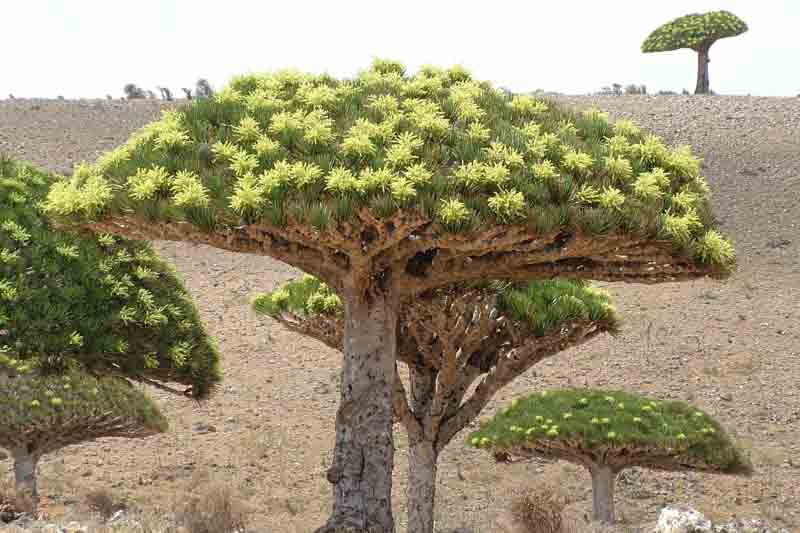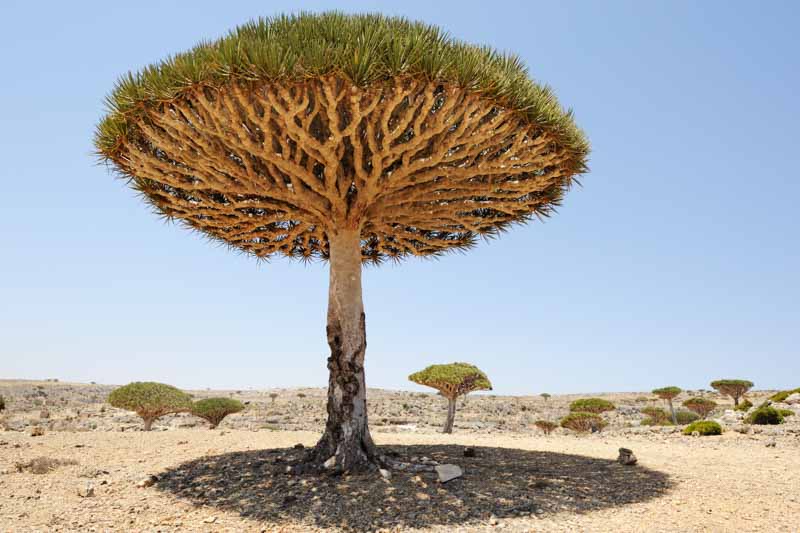Dragon Blood Tree, Socotra Dragon Tree
Dracaena cinnabari, commonly known as the Socotra Dragon Tree or Dragon Blood Tree, reveals a fascinating tapestry of botanical, ecological, and cultural narratives. This iconic tree, with its distinctive umbrella-shaped canopy and deep red sap, known as “dragon’s blood,” is not only an emblem of the Socotra archipelago but also a subject of ecological and historical significance. Dracaena cinnabari is considered the national tree of Yemen.
Dracaena cinnabari features a unique and striking appearance with a thick, water-storing trunk and dense clusters of slender, arching leaves at the ends of its branches, creating an umbrella-like canopy. The tree’s most famous feature is its resin, which is a deep, vivid red.
Native: This species is endemic to the Socotra archipelago, part of Yemen, located in the Arabian Sea. It thrives in misty, high-altitude areas, contributing significantly to the island’s biodiversity and its distinction as a UNESCO World Heritage Site. The Dragon Blood Tree belongs to the asparagus family (Asparagaceae), along with agaves and hostas.
Plant Type and Habit: It is an evergreen tree characterized by its slow growth and longevity. Its growth habit is marked by a single or sometimes branching trunk with a canopy that spreads broadly at maturity.
Size: Mature specimens can reach heights of up to 30 to 40 feet (10 to 12 meters), with a similar spread due to its wide-reaching branches. It is usually smaller in cultivation.
Longevity: Dracaena cinnabari is renowned for its considerable longevity, with some individuals believed to live for hundreds, if not thousands, of years.
Flowers: The tree produces small, white, or greenish flowers. These blossoms are grouped in dense clusters and appear at the branch tips, enveloped by the foliage. Flowering occurs from March to May, with the small, fragrant flowers attracting various pollinators. The flowers give way to small, orange to red berries, which become food for local bird species, aiding in seed dispersal.
Foliage: Its narrow leaves are rich green, strap-shaped, and leathery, up to 24 inches long (60 cm), forming dense rosettes at the branch tips, contributing to its distinctive silhouette.

Bark: The bark is smooth and gray, becoming cracked and gnarled as the tree ages, adding to its ancient appearance.
Hardiness: It is hardy in USDA zones 10 to 12 and does not tolerate frost
Uses: The dragon tree’s sap has been traded for centuries, once considered more valuable than gold. It has been used in medicine, dyes, varnish, and incense. Today, it continues to have cultural and commercial significance.
Wildlife: The dragon tree provides habitat and food for endemic bird species, insects, and other fauna of Socotra, playing a crucial role in the local ecosystem.
Toxicity: There is no significant toxicity reported in humans, making it safe in landscapes and gardens where its climatic needs can be met.
Drought: It exhibits remarkable drought tolerance, a trait that is essential for survival in the arid, rocky terrain of Socotra.
Benefits: Beyond its aesthetic appeal, the dragon tree plays a vital role in preventing soil erosion, harboring biodiversity, and contributing to the cultural heritage of Socotra.
Dracaena cinnabari should not be confused with Dracaena draco (Dragon Tree). Both trees are iconic with their umbrella-shaped canopies and red sap, known as “dragon’s blood.” While D. draco is native to the Canary Islands, D. cinnabari is native to Socotra. Both share drought tolerance and slow growth, but D. cinnabari’s habitat is more isolated, contributing to its unique ecological status.
Growing a Dragon Blood Tree indoors can be a rewarding endeavor, offering a touch of exotic allure with its distinctive silhouette and history. However, replicating its native habitat’s conditions to some extent is key to successful indoor cultivation.
Light: Position your Dracaena cinnabari where it can receive plenty of bright, indirect sunlight. A south-facing window with a sheer curtain to diffuse direct sunlight is ideal, as too much direct light can scorch the leaves.
Soil: Use a well-draining soil mix, such as a blend designed for succulents or cacti. Good drainage is crucial to prevent root rot. Ensure the pot has drainage holes. Repotting is rarely needed due to its slow growth but be prepared to do so if the plant becomes root-bound or the soil needs refreshing.
Water: Water when the top inch of soil becomes dry, reducing watering frequency in the winter months. Dracaena cinnabari is drought-tolerant, so it’s better to under-water than over-water.
Temperature and Humidity: Aim to maintain indoor temperatures between 65°F and 75°F (18°C to 24°C). Avoid sudden temperature drops and drafts. This tree benefits from moderate to high humidity. Indoor air, especially in winter, can be too dry, so consider using a humidifier or placing the pot on a tray of wet pebbles to increase humidity.
Fertilization: Fertilize sparingly, using a balanced liquid fertilizer diluted to half strength, once or twice during the growing season. Avoid over-fertilizing, which can harm the plant.
Pruning: Dracaena cinnabari requires little to no pruning. If necessary, trim away any dead or damaged foliage to maintain its appearance and health.

Propagating Dracaena cinnabari can be challenging due to its slow growth rate and the specific environmental conditions it requires to thrive. However, for enthusiasts willing to take on the challenge, here are the primary methods used for propagation:
Propagating Dracaena cinnabari from cuttings is less common and can be more difficult due to the tree’s structure and slow healing. However, if attempting this method:
Dragon Blood Trees are known for their resilience and low susceptibility to pests and diseases. However, like all plants, they can encounter certain issues, especially when not grown in optimal conditions.
Spider Mites: These tiny pests thrive in dry conditions, sucking sap from leaves, leading to yellowing and webbing. Increase humidity and wash plants with water; use miticides if necessary.
Mealybugs: Look for white, cottony masses on stems and undersides of leaves. Remove with alcohol-dipped cotton swabs or apply insecticidal soap.
Scale insects: Hard, dome-shaped pests that attach firmly to stems and leaves, feeding on sap. Their presence can lead to yellowing leaves, stunted growth, and a decline in plant health.
Root rot: Overwatering is the primary cause of root rot, which is a fungal issue. Prevent by ensuring well-draining soil and pots, and only water when the soil is dry.
Leaf spot: Caused by fungal or bacterial infections, resulting in discolored spots on leaves. Improve air circulation, reduce leaf wetness, and treat with fungicides if necessary.
Brown Leaf Tips: This can result from low humidity, over-fertilization, or fluoridated water. Use distilled or rainwater and fertilize sparingly.
Leaf Drop: Drastic changes in temperature, light, or watering can stress the plant, leading to leaf drop. Try to provide a stable environment.
Slow Growth: As a naturally slow-growing species, any additional stress from inadequate light, incorrect watering, or poor soil can further slow growth. Patience and consistent care are key.
| Hardiness |
10 - 12 |
|---|---|
| Plant Type | Houseplants, Trees |
| Plant Family | Asparagaceae |
| Genus | Dracaena |
| Exposure | Full Sun |
| Season of Interest |
Spring (Early, Mid, Late) Summer (Early, Mid, Late) Fall Winter |
| Height |
30' - 40' (9.1m - 12.2m) |
| Spread |
30' - 40' (9.1m - 12.2m) |
| Maintenance | Low |
| Water Needs | Low |
| Soil Type | Chalk, Loam, Sand |
| Soil pH | Acid, Alkaline, Neutral |
| Soil Drainage | Well-Drained |
| Characteristics | Showy, Evergreen |
| Tolerance | Drought |
| Garden Uses | Patio And Containers |
| Hardiness |
10 - 12 |
|---|---|
| Plant Type | Houseplants, Trees |
| Plant Family | Asparagaceae |
| Genus | Dracaena |
| Exposure | Full Sun |
| Season of Interest |
Spring (Early, Mid, Late) Summer (Early, Mid, Late) Fall Winter |
| Height |
30' - 40' (9.1m - 12.2m) |
| Spread |
30' - 40' (9.1m - 12.2m) |
| Maintenance | Low |
| Water Needs | Low |
| Soil Type | Chalk, Loam, Sand |
| Soil pH | Acid, Alkaline, Neutral |
| Soil Drainage | Well-Drained |
| Characteristics | Showy, Evergreen |
| Tolerance | Drought |
| Garden Uses | Patio And Containers |
How many Dracaena cinnabari (Dragon Blood Tree) do I need for my garden?
| Plant | Quantity | |
|---|---|---|
| Dracaena cinnabari (Dragon Blood Tree) | N/A | Buy Plants |
Create a membership account to save your garden designs and to view them on any device.
Becoming a contributing member of Gardenia is easy and can be done in just a few minutes. If you provide us with your name, email address and the payment of a modest $25 annual membership fee, you will become a full member, enabling you to design and save up to 25 of your garden design ideas.
Join now and start creating your dream garden!
Create a membership account to save your garden designs and to view them on any device.
Becoming a contributing member of Gardenia is easy and can be done in just a few minutes. If you provide us with your name, email address and the payment of a modest $25 annual membership fee, you will become a full member, enabling you to design and save up to 25 of your garden design ideas.
Join now and start creating your dream garden!